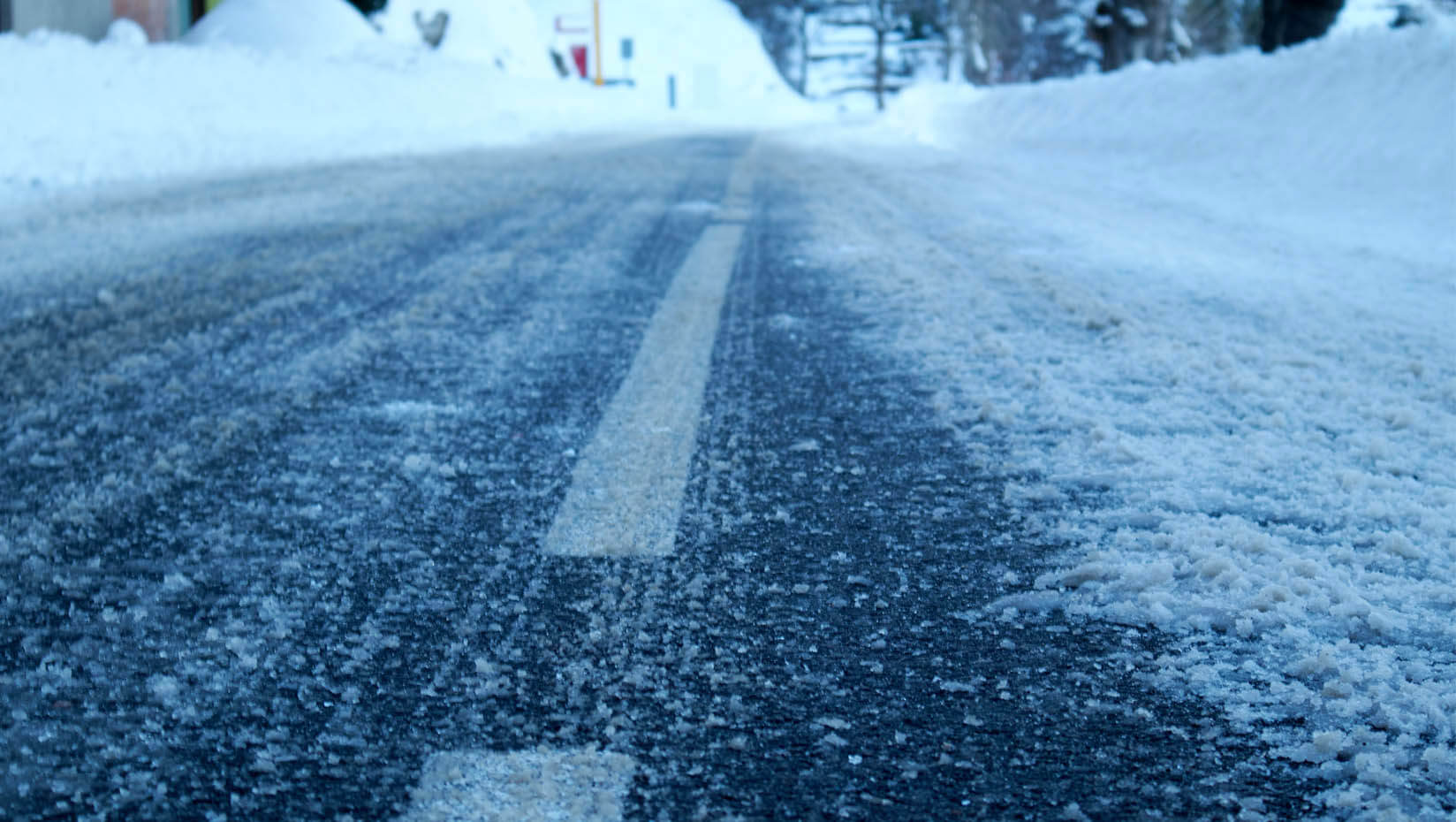
UMaine releases assessment on the practices, impacts and safety of winter road salt
The University of Maine’s Margaret Chase Smith Policy Center and Department of Civil and Environmental Engineering recently released a report in collaboration with the Maine Department of Transportation (MaineDOT) examining the practice of using road salt for winter travel safety in Maine, as well as its cost and environmental impacts. The report makes recommendations for the state based on its findings, including increased public outreach, road salt reduction plans in environmentally-sensitive areas and increased monitoring of chlorides in water bodies.
Rock salt, or sodium chloride, is the most widely used material on winter roads in Maine due to its relative cost-effectiveness and ease of handling. However, winter road salt is a significant source of chloride loading to fresh waters, which impacts ecosystems and affects the quality of drinking water while taking decades to fully recover. According to the Maine Department of Environmental Protection (MDEP), 20 streams in Maine are now noted on the list of chloride impaired urban stream watersheds.
The report, entitled “Road Salt in Maine: An Assessment of Practices, Impacts and Safety,” estimates that Maine used approximately 493,000 tons of road salt in 2019–20, equal to roughly 787 pounds of salt for every Maine resident, or 11 tons per lane mile per year.
The report evaluated the environmental impact of road salt using geospatially distributed records from well testing to assess the prevalence of chloride contamination in groundwater wells. During 2011–20, 15 towns had at least one well with a chloride concentration above the Secondary Maximum Contaminant Level, with South Thomaston in Knox county showing the highest number of contaminated wells. However, local biophysical factors play a role in the transport of road salt to groundwater, meaning that the prevalence of chloride contamination in wells across Maine cannot be directly inferred from spatial patterns of road salt application.
Though towns vary substantially in their winter maintenance costs, clearing winter roads statewide costs Maine $155 million, or $114 per resident — and that doesn’t include the costs of environmental impacts or corrosion of infrastructure and vehicles, nor does it include remediation costs of wells contaminated from road salts. Under state law, MaineDOT is obligated to resolve well claims for private water supplies that are rendered unfit for human consumption, by constructing or maintaining a highway, including the use of salts for winter road maintenance. MaineDOT has spent approximately $5.3 million since 2006 to resolve well claims.
The researchers looked at how warming winter weather over the past few decades has impacted — and will continue to impact — the use of road salt in Maine. The amount and timing of salt application on roads is closely linked to winter weather severity, but the changing climate has led to an increased variability in winter weather events, with both record low and record high snow falls occurring between 2010–19, making it more difficult to apply the necessary amount of road salt at the right time for the benefit of public safety.
Salt is an important tool for winter mobility, and winter is a dangerous time to drive in Maine. The researchers examined data from all police reported crashes from 2015–19 in Maine and matched them with daily weather data from weather stations throughout the state and found that approximately 67% of all lane departure crashes from 2010–19 occurred during the winter period.
To balance cost, environmental impact and safety, the researchers conclude that communication is key — the public needs to better understand the fiscal and environmental costs of winter maintenance, with all levels of government communicating them. That way, communities can make choices reflecting their own set of values and needs, as they do with school and police budgets.
The report recommends that Maine develop a statewide chloride reduction plan that identifies and prioritizes salt reduction in regions with environmentally sensitive areas, as well as increasing their monitoring of chlorides in water bodies and make this information easily accessible to the public via a data dashboard. More public safety and awareness campaigns around the dangers of driving in winter weather, additional signage and news reporting were also recommended.
Given the changing climate, the report also recommends that the state provide a detailed assessment of hazardous weather conditions based on hourly weather data to determine how storms mix snow, rain, freezing rain and sleet, and frost conditions throughout the state. Wintertime weather indices can offer useful guidance regarding frequency, intensity and duration of storm conditions to allow planning and decision-making regarding the use of road salt.
Collaboration at all levels of government is key. The report says that Maine could benefit from stronger connections between university research, environmental monitoring and road practitioners. A statewide organization such as the Maine Municipal Association could strengthen communication among municipalities statewide, including providing training for town managers on the impacts and tradeoffs of salt application and recent developments in the field.
The researchers outline how the experience of other states may offer lessons for Maine, such as New Hampshire providing training and liability protection to winter contractors in response to an increasing number of chloride-impaired streams, or Minnesota developing a network of Road Weather Information Systems and Automatic Vehicle Location Maintenance Decision Support System to support its DOT’s liquid anti-icing program. The report also highlighted Maine’s Long Creek Watershed Management District (LCWMD) implementing a pilot program that focuses on the cooperation of multiple stakeholders, applicator training, full cost accounting and salt reduction.
When it comes to municipalities, though, there is no one-size-fits-all approach to balancing the impacts of road salt use with the safety benefits. Maine municipalities should scrutinize their spending on winter road maintenance and look at the local environmental impacts in order to determine the next best steps for their area.
Contact: Sam Schipani, samantha.schipani@maine.edu
